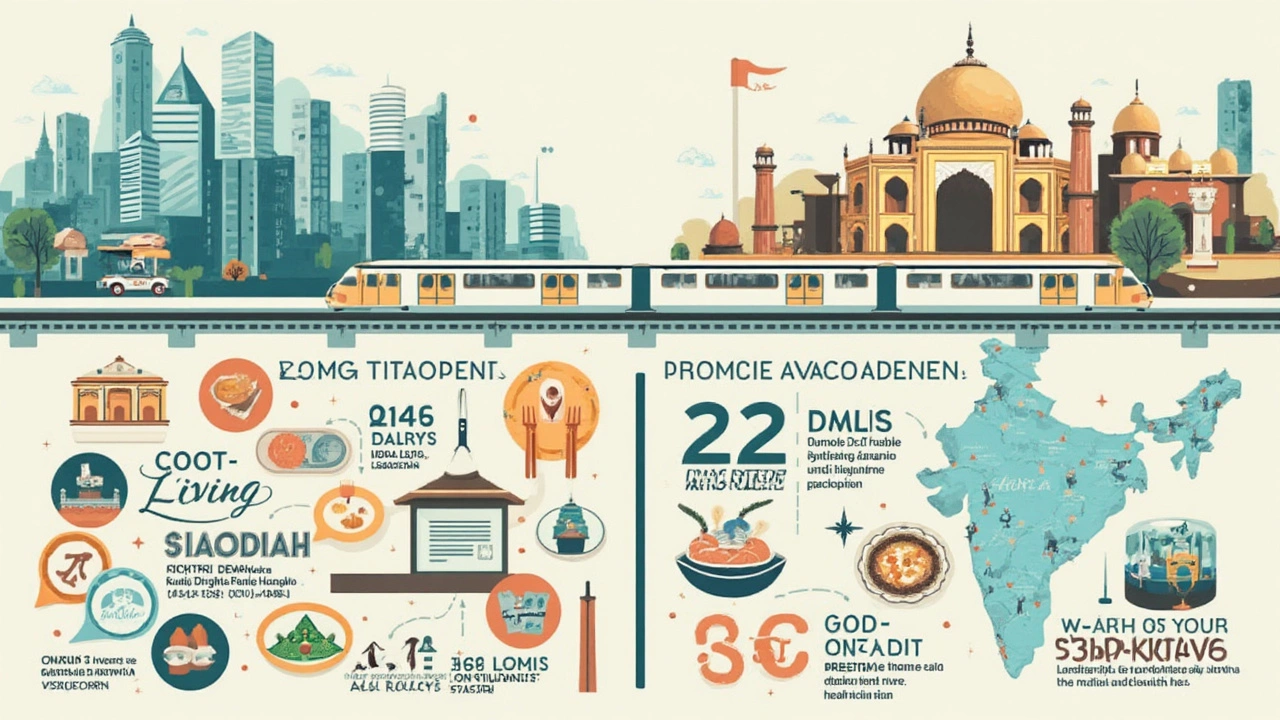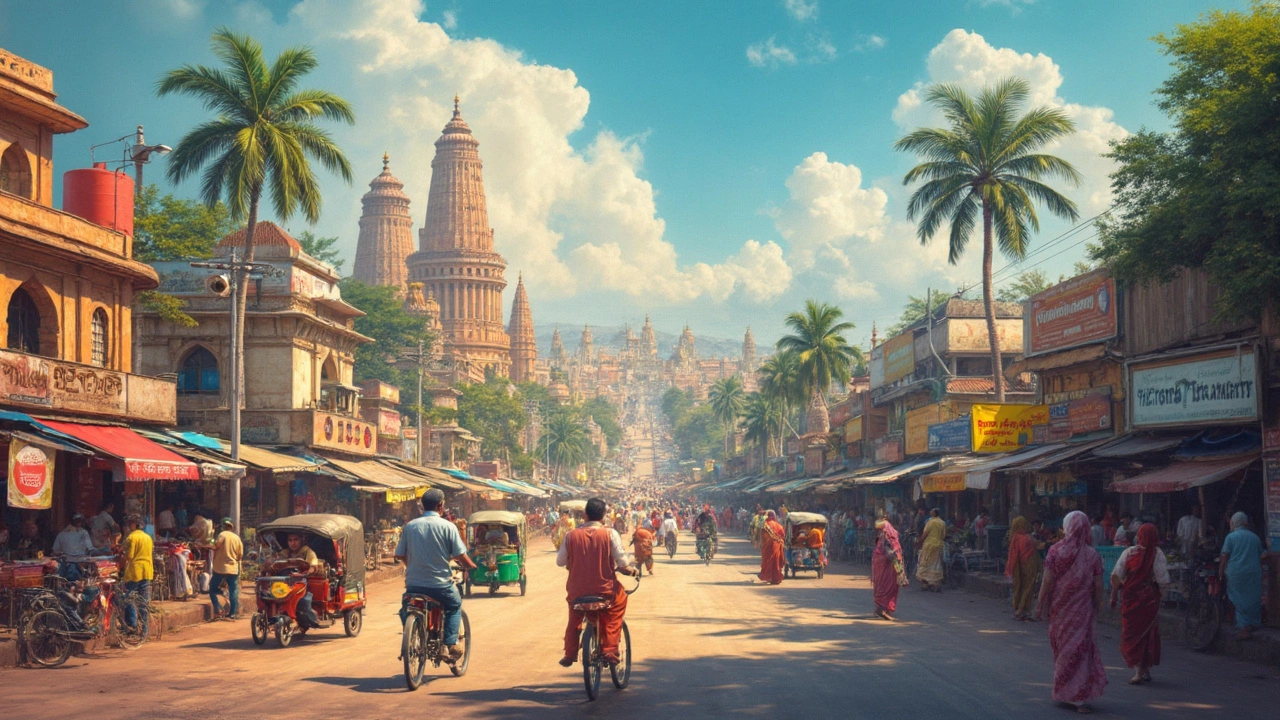The South vs North India debate always kicks up a storm, especially when it comes to wealth. Some folks swear the south is flush with money, thanks to its IT hubs and smooth roads. Others point to North India’s grand capitals and luxury malls. But which side is actually richer—and what does that mean for your travel plans?
Let’s get real. Comparing an entire half of India with another isn’t as simple as adding up bank accounts. You have big cities like Bangalore and Hyderabad driving Southern growth, while Delhi and Chandigarh put North India on the map for affluence. But there’s more beneath the surface: farm incomes, government investments, even how expensive a cup of tea is at a roadside stall. If you’re planning a trip, knowing where your rupee stretches further or where you’ll see more visible signs of development can really shape your experience.
- Money Talks: The Real Numbers
- Where Wealth Shows Up
- Traveling North on Any Budget
- Insightful Tips for Tourists
Money Talks: The Real Numbers
People love to debate whether South India or North India is richer, but the answer depends on which numbers you check. If you look at GDP (Gross Domestic Product), both sides have heavy hitters. Maharashtra leads the pack overall, but among states regularly visited by tourists, Tamil Nadu (South) and Uttar Pradesh (North) both hit big numbers. In 2024, Tamil Nadu’s GDP was around $320 billion, while Uttar Pradesh’s was close behind at about $270 billion. But per person, incomes tell a different story, and that’s what matters most when you actually travel or live somewhere.
Average per capita income—how much money the typical person makes—shines more light on this. In Kerala and Karnataka (both southern states), the average is higher than in most northern states. Delhi breaks the pattern with high earnings, but places like Bihar and Uttar Pradesh fall way behind. So, while North India has some incredibly wealthy cities, wealth is spread out a bit more evenly in the south.
Where does all this cash come from? The South has boomed in tech, manufacturing, and overseas money sent back by Indians working in the Gulf. North India has its own muscle in agriculture, traditional businesses, and public sector jobs. If you’re a tourist, you’ll probably notice the difference in everyday prices and infrastructure as soon as you hop from one region to the other.
- South Indian states tend to invest more in health and education—think better public hospitals and higher literacy rates.
- In the North, especially in cities, you’ll find bigger markets, cutting-edge malls, and luxury hotels, but step just outside the top cities and things can look very different.
- Infrastructure—roads, utilities, public transport—often feels more reliable in the south, especially outside of the biggest cities.
So if you want a straight answer: No region completely outpaces the other. North India has the numbers, but South India often feels more developed. And for South India and North India, your experience will depend on where you travel and what you focus on.
Where Wealth Shows Up
This is where the picture gets interesting. Wealth in India isn’t just about who has the flashiest buildings or the fanciest cars parked outside malls. It’s the stuff you actually notice as you travel—roads without potholes, how often the power goes out, whether public toilets don’t make you cringe.
Take South India for example. Cities like Bengaluru, Chennai, and Hyderabad lead the pack on tech jobs, strong infrastructure, and generally higher living standards. A lot of their money comes from IT, health care, real estate, and education. Walk around Bangalore, you’ll spot endless cafes, clean Metro stations, and newer buildings, especially in neighborhoods like Indiranagar or Banjara Hills in Hyderabad. Even the government schools often look upgraded compared to what you’ll see in some northern towns.
On the flip side, parts of North India like Delhi, Chandigarh, and Gurgaon stand out for their showy wealth—fancy cars, luxury condos, mega shopping centers. Delhi NCR is packed with gated communities, international schools, and restaurants that could be dropped into any global city. Chandigarh is known for how organized and clean it feels, and its parks and cycling tracks are more than just Instagram bait—they actually work for locals.
But, there’s a big gap when you step out of those metros. In North Indian states like Uttar Pradesh or Bihar, you’ll notice sharp contrasts. Some of the richest politicians and landowners live just a few kilometers from areas that struggle with basic water and electricity. South India also has poorer states like Andhra Pradesh or pockets of rural Tamil Nadu. Still, if you compare overall, the southern states tend to spend more on public health and education, so the benefits feel a bit more spread out.
For travelers, this means you might find slicker public amenities in southern cities, while big northern metros give you more access to luxury and nightlife. If you want clean city buses, efficient apps for cabs, or public parks you actually want to use, Southern cities come out ahead. But if you’re after grand displays of old money—palaces, heritage hotels, or crazy wedding processions—northern cities might show you a glitzier side of wealth.

Traveling North on Any Budget
North India isn’t just for backpackers or the luxury crowd—it’s a goldmine for every kind of traveler. Whether you’re splurging in Delhi’s five-star hotels or grabbing momos from a corner shop in Manali, you actually have tons of options to fit your wallet.
The great thing here: basic conveniences like street food, shared rickshaws, and local guesthouses keep travel costs low. A plate of chole bhature in Amritsar rarely crosses ₹80, and you can hop on long-distance trains like the Shatabdi Express (Delhi to Chandigarh) for less than ₹600 in standard coaches. If you want to stretch further, just stick to offbeat towns like Rishikesh or Bundi, where hostels start at ₹300 a night and meals hover around ₹100.
| City | Budget Stay per Night (INR) | Average Meal (INR) | Popular Free Attraction |
|---|---|---|---|
| Delhi | ₹400–₹900 | ₹100–₹200 | India Gate |
| Agra | ₹500–₹1000 | ₹120–₹250 | Taj Mahal (from outside) |
| Varanasi | ₹350–₹800 | ₹80–₹150 | Ganga Aarti |
| Jaipur | ₹450–₹900 | ₹120–₹220 | Hawa Mahal (from outside) |
If you’re looking for tricks to save more money, trains and buses are your best bet for getting around, especially with new apps making ticket booking simple. Don’t forget, North India has solid tourism infrastructure, so you can find budget hotels near most rail stations. When it comes to big attractions like the Taj Mahal, consider combo tickets or off-season visits for deals—the entry fee for foreigners is ₹1100, but Indians pay only ₹50, and kids under 15 are free.
- Street markets beat malls for both souvenirs and snack prices.
- Look up local government tourism guesthouses—cheaper than many private options, clean, and often in top spots.
- If you’re traveling during a festival (like Holi or Diwali), book rooms way in advance to avoid price hikes.
North India’s variety means you don’t have to be loaded to have a great time. Mix smart planning with a bit of flexibility and you’ll see just how far your rupees can go here.
Insightful Tips for Tourists
If you're heading to North India, a few smart moves can make your trip smoother and less stressful. First off, the price difference between big cities and smaller towns is massive. For example, your daily spend in Delhi can easily triple compared to what you'd pay in a quiet hill town like Mussoorie. Here's a quick look at some real costs you might run into:
| Expense | Delhi (₹) | Varanasi (₹) | Shimla (₹) |
|---|---|---|---|
| Budget Hotel (per night) | 1500 | 900 | 1100 |
| Local Meal | 250 | 120 | 180 |
| Taxi (5km) | 250 | 150 | 200 |
Besides cost, there are other real differences. Public transport is better inside big cities, but if you're going off the beaten track, buses can be crowded and slow. Trains are king in the north, so try book tickets in advance—especially for routes like Delhi to Agra or Lucknow to Varanasi. Using local apps like IRCTC or RedBus will save you time and headaches.
Safety is something you can’t ignore. Stick to trusted taxi services or use platforms like Ola and Uber when getting around after dark. In cities like Jaipur and Amritsar, bargaining is normal at markets but skip the pushy guides—many are not certified and might overcharge.
- Carry some cash for rural areas, as digital payments still haven’t taken over everywhere.
- North India can get brutally hot in summer (over 40°C is not rare between May and June), so plan indoor sights for the afternoons and drink lots of water.
- Respect local dress codes at religious sites—covering shoulders and legs is often a must in temples and mosques.
- Don’t rely just on English; picking up basic Hindi phrases goes a long way, especially in local markets.
For anyone interested in North India tourism, don’t ignore local festivals. Holi in Mathura, Diwali in Varanasi, or the Pushkar Camel Fair are unforgettable, but book your stay months in advance because these towns fill up fast. Remember: North India is about diversity, and every state offers a mix of rich history, food, and experiences that'll keep you coming back.
